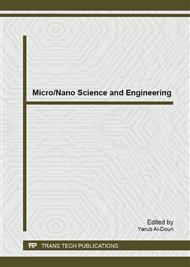p.62
p.67
p.72
p.77
p.82
p.84
p.88
p.92
p.96
Effect of Methyl Cellulose on Apatite Formation of a Sol-Gel Derived Bioactive Glass/Titania Nanostructure Composite
Abstract:
In order to widen the application range of bioactive glass (BG), we prepared a bioactive glass as a composite matrix, strengthened by titania nanoparticles. The prepared composites had different amounts of both bioactive glass (49S) and titania in the weight percents of 1:3, 1:1 and 3:1, respectively. Bioactive glass sols (49S) in the system (SiO2CaOP2O5) were prepared following the solgel technique, then a solution of 2 wt% methylcellulose was added and stirred at room temperature. Precalcinated TiO2 nanopowder was dispersed in the sol and the prepared mixture was fired at 600 °C. The inhomogeneity problem in preparation of composite powder was overcome by using methylcellulose (MC) as a dispersant. The nanostructure composites were characterized using X-ray diffraction (XRD) and Fourier transforms infrared spectroscopy (FT-IR). The microstructure of the surfaces of the different composites was examined by scanning electron microanalysis (SEM) to verify the apatite formation. The results led us to the conclusion that the addition of MC reinforces the composites and increases the formation of an apatite layer in the presence of BG and titania content.
Info:
Periodical:
Pages:
82-83
Citation:
Online since:
April 2014
Keywords:
Price:
Сopyright:
© 2014 Trans Tech Publications Ltd. All Rights Reserved
Share:
Citation:


